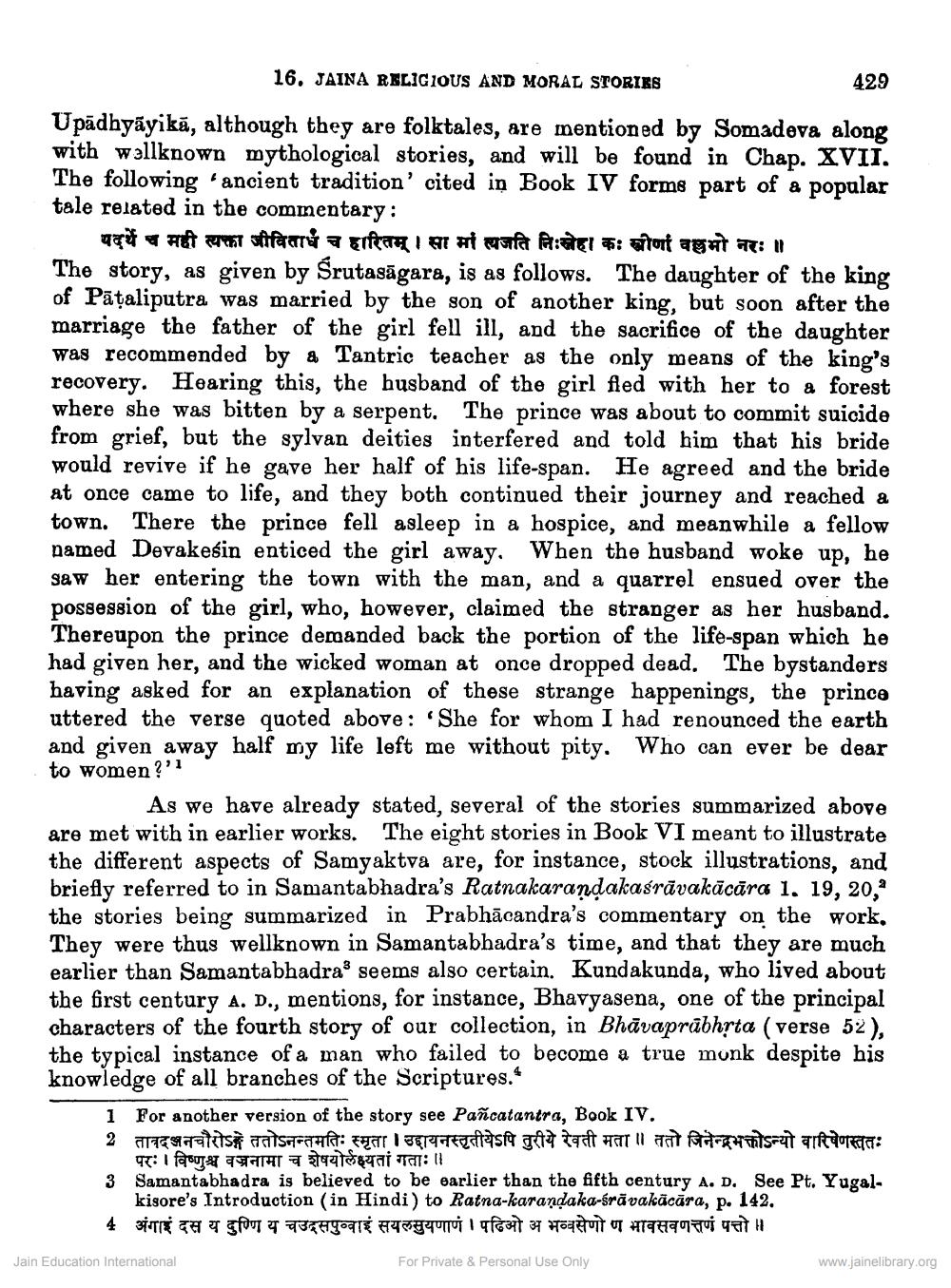________________
16. JAINA RELIGIOUS AND MORAL STORIES
429
Upādhyāyikā, although they are folktales, are mentioned by Somadeva along with wallknown mythological stories, and will be found in Chap. XVII. The following ancient tradition' cited in Book IV forms part of a popular tale related in the commentary:
पदर्थे च मही त्यक्ता जीविताधं च हारितम् । सा मां त्यजति निःनेहा कः स्त्रीणां वल्लमो नरः ॥ The story, as given by Śrutasāgara, is as follows. The daughter of the king of Pāțaliputra was married by the son of another king, but soon after the marriage the father of the girl fell ill, and the sacrifice of the daughter was recommended by & Tantric teacher as the only means of the king's recovery. Hearing this, the husband of the girl fled with her to a forest where she was bitten by a serpent. The prince was about to commit suicide from grief, but the sylvan deities interfered and told him that his bride would revive if he gave her half of his life-span. He agreed and the bride at once came to life, and they both continued their journey and reached a town. There the prince fell asleep in a hospice, and meanwhile a fellow named Devakesin enticed the girl away. When the husband woke up, he saw her entering the town with the man, and a quarrel ensued over the possession of the girl, who, however, claimed the stranger as her husband. Thereupon the prince demanded back the portion of the life-span which he had given her, and the wicked woman at once dropped dead. The bystanders having asked for an explanation of these strange happenings, the prince uttered the verse quoted above: "She for whom I had renounced the earth and given away half my life left me without pity. Who can ever be dear to women?'!
As we have already stated, several of the stories summarized above are met with in earlier works. The eight stories in Book VI meant to illustrate the different aspects of Samyaktva are, for instance, stock illustrations, and briefly referred to in Samantabhadra's Ratnakarandakaśrāvakācāra 1. 19, 20, the stories being summarized in Prabhācandra's commentary on the work. They were thus wellknown in Samantabhadra's time, and that they are much earlier than Samantabhadra seems also certain. Kundakunda, who lived about the first century A. D., mentions, for instance, Bhavyasena, one of the principal characters of the fourth story of our collection, in Bhāvaprūbhrta (verse 52), the typical instance of a man who failed to become a true monk despite his knowledge of all branches of the Scriptures."
1 For another version of the story see Pañcatantra, Book IV. 2 तावदानचौरोडौं ततोऽनन्तमतिः स्मृता । उहायनस्तृतीयेऽपि तुरीये रेवती मता ॥ ततो जिनेन्द्रभक्तोऽन्यो वारिषेणस्ततः
परः । विष्णुश्च वजनामा च शेषयोलेक्ष्यतां गताः।। 3 Samantabhadra is believed to be earlier than the fifth century A. D. See Pt. Yugal
kisore's Introduction (in Hindi) to Ratna-karandaka-śrāvakācāra, p. 142. 4 अंगाई दस य दुण्णि य चउदसपुव्वाइं सयलसुयणाणं । पढिओ अ भव्बसेणो ण भावसवणत्तणं पत्तो॥
Jain Education International
For Private & Personal Use Only
www.jainelibrary.org




